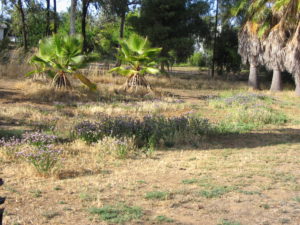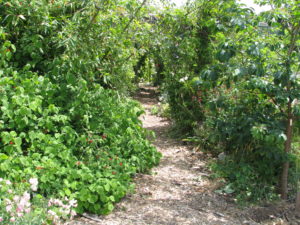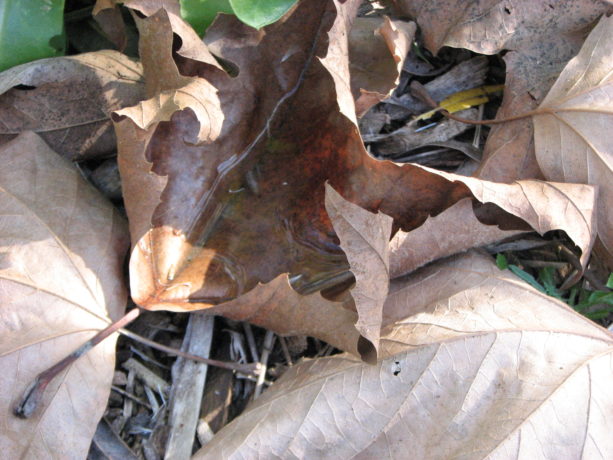Shade

 In drylands there is a noticeable lack of trees. This situation is kind of a Catch-22. The hotter and drier it is, the less water there is in the ground to provide for plants that can attain height, and the more the leaves of the existing trees must adapt (become smaller) to prevent transpiration and sunburn. Yet the very lack of trees and their extensive root systems, and the shade and habitat they create, and the transpiration that allows humidity to keep the air moist for pollen to survive, is one of the causes of desertification.
In drylands there is a noticeable lack of trees. This situation is kind of a Catch-22. The hotter and drier it is, the less water there is in the ground to provide for plants that can attain height, and the more the leaves of the existing trees must adapt (become smaller) to prevent transpiration and sunburn. Yet the very lack of trees and their extensive root systems, and the shade and habitat they create, and the transpiration that allows humidity to keep the air moist for pollen to survive, is one of the causes of desertification.
So how do we stop this cycle?
First, work on a manageable area. If you have a large property, then start on the area closest to your home or where you need water the most, or where water settles. As in the Annie Lamont title, Bird by Bird, you work on a piece a little at a time.
- Put in earthworks to harvest rainwater. Simple swales or rain catchment basins, perpendicular to the water flow and on contour with your property, will harvest hundreds of gallons of water each rain. You can do them with tractors, you can do them with shovels, you can do small ones with trowels above small plants. Just do them.
- Bury organic matter: hugelkultur. Do you have old wood laying around? Palm trees that are growing and being a fire hazard? Old untreated lumber full of nails? Branches? All of this can be layered into the ground. Bury organic matter downhill from your swales. If you cannot bury, then pound sticks vertically into the ground. The important thing is that you are adding organic material back into your depleted soil. It will hold rainwater, it will activate soil microbes and fungi, it will open oxygen and nutrient channels, it will sequester carbon and make it available to the plants. Our soil is mostly just dead dirt. By layering organic material with dirt you are doing what nature does, but at an accelerated pace.
 If your soil is unmanageable, or you can’t dig, then layer on top of the soil. Its called, among other things, lasagne gardening. Lay out newspaper, top it with fresh grass clippings or other greens, top that with dried grass clippings, dried leaves or other ‘brown’ materials, and depending upon what you want to plant in this, you can top it with mulch or with a layer of good compost and then mulch. Then plant in it! You create soil on top of the ground.
If your soil is unmanageable, or you can’t dig, then layer on top of the soil. Its called, among other things, lasagne gardening. Lay out newspaper, top it with fresh grass clippings or other greens, top that with dried grass clippings, dried leaves or other ‘brown’ materials, and depending upon what you want to plant in this, you can top it with mulch or with a layer of good compost and then mulch. Then plant in it! You create soil on top of the ground. - Mulch and sheet mulch! Protect your soil from the heat and wind, and from pounding rain. A thin layer of bark will actually heat up and accelerate the evaporation process: add several inches of mulch to the ground. Better yet, sheet mulch by laying cardboard and/or newspaper directly on top of the weeds and layering an inch or more of mulch on top.
 This can be free mulch from landscapers, old weeds, grass clippings, animal bedding, softwood cuttings… just cover the soil to keep it moist and protected. Thick mulching alone will help keep some humidity in the air and begin soil processes, as well as reduce evaporation by reflected heat that comes from bare earth or gravel.
This can be free mulch from landscapers, old weeds, grass clippings, animal bedding, softwood cuttings… just cover the soil to keep it moist and protected. Thick mulching alone will help keep some humidity in the air and begin soil processes, as well as reduce evaporation by reflected heat that comes from bare earth or gravel. - Plant native plants. They thrive in our soil. Grow trees that filter the sun and don’t like a lot of water, such as palo verde, or those that take minimal additional water such as desert willow, California redbud, valley oak, or others. Grow tall bushes such as toyon, lemonadeberry, sugarbush, quailbush, ceanothus
 or others. Use these wonderful plants to invite in birds,butterflies, lizards and other wildlife that will begin pollination and help activate the soil.
or others. Use these wonderful plants to invite in birds,butterflies, lizards and other wildlife that will begin pollination and help activate the soil. - Design your garden for what you want to grow besides natives. Fruit trees? Vegetables? Ornamentals? They can be arranged in your mulched area in guilds to grow cooperatively.
- Grow shade. Fast-growing trees and shrubs are invaluable for protecting – ‘nurserying in’ – less hardy plants. Acacia and cassia are both nitrogen-fixers and will grow quickly to shade your plants, can be cut for green waste in the fall and also attract pollinators. Moringa is completely edible and is also an excellent chop-and-drop tree. There are many others. You need to protect what you plant from the harsh summer sunlight, and using sacrificial trees and shrubs is the most productive way to do it.
- Protect your tree trunks from scorching by growing light vines up them, such as beans or small squash.
Once you have done this process in one area, then move on to the next, like a patchwork quilt. These areas should all be planted in accordance with a larger plan that covers your entire property, so that you plant what you want in the best possible place. However, the earthworks, hugelkultur and mulching can be done everywhere. By following these guidelines, and working one small area at a time, you’ll have success, have trees, shade, food and be helping reverse desertification, one plot at a time.

6 Comments
Diane
Jane, it sounds wonderful, even with the ants and capeweed! We have cursed Bermuda grass, and Argentine ants, among others. Well, I just don’t know, but you might still keep the bee suit dusted off and try some hand pollinating just for the heck of it.
Jane
I put aged horse manure on my beds a few weeks before planting in them and let the chooks scratch through it for a week or so then water, mulch and fence it off from the chooks and it is usually planted within the next couple of weeks. I had bhuddleia growing nearby and some gone to seed coriander and lettuce. At various times there are roses and irises in bloom and the cursed capeweed. I have found mint impossible to grow until recently, it looks like it’s taken on one of the swale banks. I never use sprays or poison of any kind. I also have seen native bees, native mud wasps and ladybirds. We also have fifty million, nine hundred and ninety two ants in assorted sizes and ferocity.
Diane
What a puzzler. It does sound like pollination. I’m sure that you’ve done all these things, but here’s some input: pumpkins are heavy feeders, but don’t like a lot of nitrogen so green waste in their planting holes isn’t as good as well-rotted compost or manure. They have the best seeds when fully mature, so wait until the vines are totally dead, and preferably temperatures go down a little, to harvest. Multiple pollinators and frequency of pollination is important for lots of seeds. If all you have are honeybees, which mark the flowers that they visit by changing the ionic charge, then perhaps the flowers aren’t being visited enough. You can plant insectiary plants – usually those with tight groupings of small flowers such as the carrot and mint family – near by to attract other native pollinators, or you can be a big bee yourself and take a clean paintbrush and start dabbing from males to females. It could be that some of the pollen is drying out and therefore not being viable even if the flowers are being well visited, but the mulch shouldn’t be the problem. Dry air usually is, which both of us have. Water features and shade trees are the answer for this, but on the practical side hand pollination with a combination of pollen from any open male flowers would be the best bet. So get your bee suit out! 🙂 I hadn’t heard of styrian before, although I’ve seen other hulless varieties. Sound great!
Jane
Hi Diane, the pumpkin plants were healthy and happy looking. I mulched them quite thickly as I had the bottles in place and didn’t want the water to evaporate. They looked really good all summer. They were Styrian pumpkins and came from a packet. They kept producing pumpkins until the first frost. Some ripened some didn’t have time before the frost, but the results were the same for all of them. I have a different variety of naked seed pumpkin to try this year. A friend who also grew the Styrian last summer had no problems. She lives in a slightly different climate zone to me. She grows lots of pumpkins every year and always gives me some so I didn’t miss out completely! She suggested I may have had a pollination problem, but because there were so many bees I didn’t agree until I read you comments about the air being too dry, but then I did have normal looking pumpkins so I wasn’t completely sold on that idea either. Anyway next doors sheep had a good feed! Jane.
Diane
Hi Jane! How very frustrating! I don’t think pollination was an issue with your second batch of pumpkins. Pumpkins are thirsty but don’t like their roots wet. If the leaves were healthy green and you had an abundance of vegetables, then the plants were fine. Thin layers of mulch where you can see dirt in between will exacerbate evaporation, but thick layers of mulch, or sheet mulch, will protect moisture levels and not dry out the air. What variety of pumpkins did you plant? Were the second year’s pumpkins planted from the first year’s saved seed, or from the packet? Diane
Jane
Hi Diane, I read with interest your comments about air drying out and affecting pollen. I don’t have an irrigation system. If I have to water I do it with a watering can and buckets. The summer before last I grew a type of pumpkin grown for their edible seeds, not their flesh. All summer I carried water to them and got just a couple of pumpkins which were full of lovely seeds. Then I read a blog that mentioned piercing plastic bottles and burying them in the ground and filling them with water, which is what I did last summer. I got heaps of pumpkins and the bees were all over the flowers all summer and I was looking forward to lots of tasty seeds and some to sow for next summer. However when I cut into the pumpkins they were full of embryo seeds which hadn’t developed at all. So disappointing! I guess the plants grew well because the water was going directly to their roots, but the mulch kept the air around the plants too dry, maybe.
I am still a bit puzzled though as to why I got so many pumpkins that outwardly looked perfectly normal if there was a pollination problem. Next season I will try them as ground cover round the fruit trees.